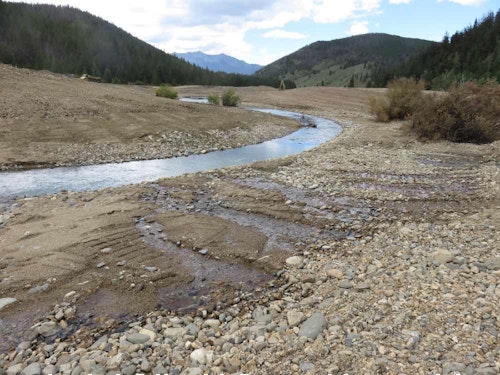The same source of conservation funding — excise taxes paid by tackle manufacturers via the Sport Fish Restoration Act — that pays for scientific fisheries research and management, boat ramps, aquatic education, and fish population surveys, has righted an upside down trout stream.
Colorado’s Swan River heads in the craggy and conifer-studded Rocky Mountains near a tourist mecca of Breckenridge. This was gold country. Dating to the 1890s, dredge barges plowing through the supine streamside meadows and the river proper inverted the river bottom and flood plain. Dredges sifted and separated the yellow metal from sands and gravels. Gone is the gold. Left behind was a most unusual spoil of sand, cobbles and rubble that once constituted trout habitat. The long, meandering pile of spoils looked from a distance like massive gray welts where there was once been a silver river bending through a verdant valley at 9,600 feet above sea level.

The Swan River certainly continued to flow — percolating beneath the long welts — hidden for decades from life-giving sunlight and depriving caddis and midge and mayflies, and the Colorado River cutthroat trout and brook trout that eat them, of their habitats. The nearly 2.5 miles of hidden river were not accessible to anglers, either.
But that has changed. A partnership involving Colorado Parks and Wildlife, the U.S. Fish and Wildlife Service and a litany of other organizations such as Summit County and White River National Forest are well into restoring trout habitat to the formerly hidden reach of river, reconnecting tributary streams to the main stem Swan as well.
After much planning and preparation, restoration started in earnest in 2016. Something this massive is taken on in smaller pieces. Approximately a mile’s worth of the massive pile of stones have been removed and put to good use, and the natural stream channel revealed. Stones comprising the former valley bottoms are used to shape and steer the river channel, to bend and curl stream flow across the valley floor as flowing water desires to do. The excess spoils have been extracted and reduced to base material for county roads and state highways.

Another 3,100-foot-long river section is presently under restoration with streamside and upland vegetation planting to secure the soils in place and provide eventual cooling shade over the water. Woody debris and boulders set in place direct and slow stream flows and make lairs for trout to hold and feed — and await an angler’s properly drifted elk-hair caddis.
The trout have returned. Fish population surveys by Colorado Parks and Wildlife biologists revealed that brook trout have taken to the newly renovated stream sections. In 2016, a fishery survey documented only a few hundred brook trout larger than 6 inches per mile of stream. Three years later the renovated Swan River sections contained more than 1,800 brook trout per mile of stream, 6 inches and bigger. Moreover, fish biologists discovered that the numbers of mottled sculpin, a curious looking finger-sized fish with broad fanning pectoral fins that hold it in place on the river bottom in fast waters, have proliferated. The sculpin’s presence in impressive numbers is indicative of high-quality fish habitat.
The Swan River restoration in not complete. There is more stone to remove and re-purpose instream and elsewhere. More streamside plantings to come. In the end, expect more habitat for anglers where there had been none for more than a century.
To learn more, visit Partner with a Payer.
Photos courtesy of Colorado Parks and Wildlife, and the U.S. Fish and Wildlife Service.







